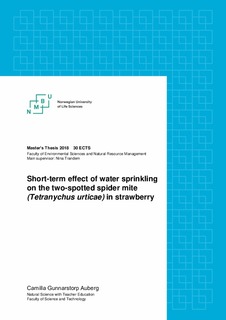| dc.description.abstract | The two-spotted spider mite, Tetranychus urticae, is a common pest on strawberry plants and especially when cultivating strawberry plants in tunnels due to the mites’ preference for warm and dry conditions. A common control method is to apply pesticides, but it is advantageous to use measures that do not entail dangerous substances. This can be achieved by using IPM (integrated pest management) methods. This study addresses water sprinkling as an IPM method to reduce spider mite populations, focusing on the short-term effect of one minute of irrigation. The spider mites were studied through three experimental runs where leaflets from strawberry plants were sampled before irrigation, one minute after irrigation and 24 hours after irrigation of whole plants. The experimental runs were done on a growing spider mite population and revealed an interaction between the effect of the water sprinkling and run, probably due to the differences in the spider mite population size. The total number of all individuals in mobile life stages showed no effect of the water sprinkling, comparing the three times sampled (i.e. before, 1 minute after and 24 hours after irrigation). However, when analyzing each life stage (eggs, larvae, nymphs, adult females and adult males) separately, time after irrigation had an effect in all life stages. The results suggested that there was a short-term effect of the water sprinkling 1 minute after irrigation where the number of nymphs and adult males was reduced, but also a short-term effect 24 hours after irrigation resulting in a reduction of eggs, larvae, nymphs, adult females and adult males, all in which the numbers of spider mites decreased for one of the two experimental runs with a high number of mites. One of the 12 possible positions for the experimental plants where the leaflets were sampled differed from the other positions by having the fewest mean number of spider mites at all three sampling times.
In conclusion, the short-term effect of one minute of irrigation was not clear-cut and because one minute of irrigation per day was not enough, water sprinkling should be used with other IPM methods to increase the effect. | nb_NO |

